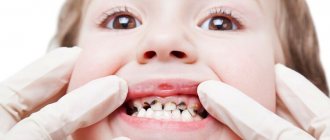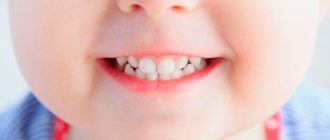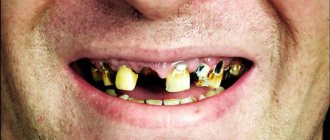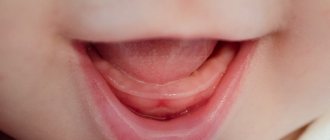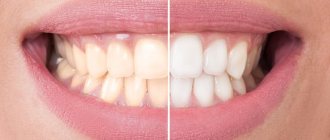By the age of 2-3 years, the baby usually has all 20 baby teeth. And, it would seem, it’s time to enjoy childhood and eat goodies, but not everything turns out so simple. The first teeth have a thin layer of enamel, so they are often affected by caries, which progresses quickly. Let's talk about what to do if you notice rotten baby teeth in your child.
How does childhood dental caries occur?
According to statistics, caries in children under three years of age occurs in 90% of cases, that is, 9 out of 10 children have dental caries. This term refers to the pathological, slow process of destruction of hard tooth tissue under the influence of unfavorable factors.
In this article
- How does childhood dental caries occur?
- The main causes of dental caries in children 1 year of age
- Features of bottle caries
- A one-year-old child has caries - what to do?
- How will caries be treated for a one-year-old child?
- How is deep caries treated for young children?
- How to prevent caries in one-year-old children: preventive measures
The oral cavity is home to many microorganisms, including cariogenic bacteria. They can ferment sugars into acids that are destructive to dental tissue. When the number of these bacteria in the mouth increases sharply, they produce large amounts of acid, which causes dental caries in the child.
What to do if baby teeth grow crookedly?
If parents notice that their child’s baby teeth are growing crookedly - for example, there is crowding or improper occlusion - this is a reason for a mandatory consultation with a pediatric orthodontist. It happens that due to anomalies of the facial skeleton (in particular, improper development of the jaws), defects are noticeable even with a primary bite, and with a permanent bite they will persist and worsen.
Therefore, it is recommended to show the child to an orthodontist from the age of three to determine whether there is pathology and find methods for its correction. There are malocclusions that are easily corrected at an early age and extremely difficult to correct in adults.
The main causes of dental caries in children 1 year of age
The main cause of tooth decay is exposure of teeth to acid produced by bacteria. At the same time, a number of reasons contribute to the increase in the number of pathogenic microorganisms in the oral cavity and the negative impact of these bacteria on teeth.
- Lack of proper care.
Many parents do not consider it necessary to brush their one-year-old child's teeth. Some are convinced that daily hygiene should begin only after all baby teeth have erupted. Others are afraid to injure the baby’s tender gums with a brush. Still others are sure that caries cannot damage teeth in one year, because the child eats only “baby” foods. Dentists say that dental caries in children can develop at any age. Regular and high-quality timely brushing of teeth is one of the most important conditions for maintaining dental health. It is necessary to start brushing with the appearance of the first tooth, that is, long before the child turns one year old.
- Long-term bottle feeding.
The teeth of a child who eats formula from a bottle for a long time are susceptible to developing so-called bottle caries. Its development begins with the upper front incisors. As a rule, it is localized in the cervical and contact areas.
- Infection from parents.
Cariogenic bacteria can enter the mouth of a one-year-old child from an adult. This happens when kissing on the lips or when a mother licks a pacifier and gives it to her baby. To reduce the risk of pathogen transmission, it is important for mom and all family members to monitor their dental and oral health.
- Congenital problems.
A predisposition to the development of caries may be associated with a violation of the correct formation of teeth during the prenatal period, a lack of minerals and vitamins, and diseases that a woman suffered during pregnancy.
- Abuse of sweets.
The most common cause of dental caries in children is an excess of sweet candies, juices, and foods high in fast carbohydrates in the diet, which are a breeding ground for cariogenic bacteria. Children under one year old are not recommended to consume sugar at all, but many parents ignore this advice from doctors and begin to give store-bought juices, sweets, and ice cream from 8-9 months. Improper eating behavior increases the risk of dental caries in a child several times.
- Lack or excess of fluoride.
Fluoride is an essential element that affects dental health. A lack of this component, as well as its excess, can cause dental problems, including caries in children.
Do I need to remove rotten teeth?
If a tooth root or crown is completely rotted, it cannot be restored. Such a tooth cannot be left in the jaw so that its purulent contents do not spread to the surrounding tissues. If there is rot in the root canals, it is not possible to make artificial crowns, since they will not be able to fix on the destroyed tissues. Therefore, in advanced situations, dentists prescribe the removal of a rotten tooth, and this operation cannot be refused. After removal, a course of antibiotics may be prescribed.
To prevent your teeth from rotting, you need to regularly monitor their condition. To maintain dental health, you need to adhere to a nutritious diet and maintain oral hygiene, as well as promptly treat any dental and internal diseases. Purulent processes are extremely dangerous, therefore, if the carious process has reached an advanced stage, you should not refuse to remove the diseased tooth.
Features of bottle caries
Bottle caries in a child under 1 year of age is one of the most common types of carious lesions in primary teeth. It occurs when young children are bottle-fed before bed. As a result, food remains in the oral cavity, which bacteria actively process while the child sleeps.
There is a myth that bottle caries cannot occur if the child is fed natural products - milk, kefir, juice without sugar. But cariogenic bacteria feed not only on artificial, but also on “natural” sugars - lactose, fructose, so the “naturalness” of children’s products does not reduce the risk of developing bottle caries.
Restoration of baby teeth
If a child’s baby tooth breaks off or if the dental crown is severely damaged by caries, restoration is carried out. However, if for adult patients one of the most important aspects during restoration is aesthetics, then for children functionality is much more important. Therefore, restorative filling materials are always selected taking into account the patient’s age - for children, durability and impeccable aesthetics are not so important, a good marginal fit of the fillings and the preservation of dental tissues are much more important. Filling materials that are too strong can put pressure on dental tissues and contribute to their destruction, and therefore dentists choose materials that will recreate and maintain the integrity of the dental crown until the moment of natural tooth loss.
How will caries be treated for a one-year-old child?
For young patients, the most gentle, gentle treatment is usually selected. In modern clinics, when treating young children, doctors try to ensure that the appointment time does not exceed 30 minutes.
If anesthesia is necessary, application is mainly used; in rare cases, an anesthetic injection is given. For babies under one year of age, it is preferable to treat caries using non-invasive methods, without drilling. But such therapy is justified and effective only if caries is detected early at the spot stage.
The most popular methods of treating caries in children.
- Remineralization.
Remineralizing therapy at the carious stain stage helps restore the mineral composition of the enamel, restore its strength and prevent the destruction of dental tissues. The essence of the method is that gels and pastes containing phosphorus, calcium and other components beneficial to dental health are applied to the surface of the enamel. Remineralization can be carried out both in a dental clinic and at home, using products recommended by the doctor. Home treatment is preferable for one-year-old children, because the mother or another family member will treat the teeth, and the baby will feel comfortable.
- Silvering.
Today this technique is considered outdated, although in some clinics it is still used to treat caries in children under three years of age. The essence of the method is that the enamel is coated with a 30% solution of silver nitrate, which neutralizes the activity of bacteria and stops the process of tooth decay. Among the main disadvantages of the method is a decrease in the aesthetics of the smile, because after silvering, white teeth turn black.
- Ozone therapy.
A modern non-contact method of caries treatment that is suitable for children of any age. It is based on the antibacterial effect of ozone, which neutralizes carious lesions at an early stage and disinfects the tooth. Usually ozone therapy is combined with remineralization. First, the affected area is cleaned with ozone, and then the enamel is coated with strengthening compounds.
Which treatment method to choose for a particular child is determined by the dentist after the first appointment.
Why treat baby teeth?
Rotten baby teeth do not always attract the attention of parents. Especially if the pathological processes are painless and do not bother the child. Adults think that when the bite changes, the bad teeth will disappear by themselves, and instead of rotten teeth, normal molars will grow. Dentists warn about the fallacy of such a misconception.
Rotten milk teeth are:
- damage or destruction of tooth germs - a high risk that the root units will grow sick or not appear at all;
- early loss of primary occlusion units - leads to displacement of existing teeth, the appearance of crowding, and the formation of a pathologically abnormal bite;
- an ugly smile, an unaesthetic appearance - the appearance of complexes due to appearance in young children, decreased contact with peers, uncertainty, isolation;
- deterioration of diction - rotten, breaking teeth interfere with the correct movements of the tongue during speech, leading to a lisp, burr;
- gradual spread of infection - damage not only to the surface of the teeth, but also to the pulp, development of pulpitis, the appearance of an abscess, as well as a tendency to ENT diseases and gastrointestinal diseases.
How is deep caries treated for young children?
If a one-year-old child is diagnosed with deep caries, it cannot be treated like a superficial one, without drilling. In this case, the teeth are filled with photopolymer composite or glass ionomer cement. To ensure that the baby sits still or as calm as possible during treatment, sedation or general anesthesia is used. Unfortunately, any anesthesia has a number of side effects, so it is better not to start caries and treat it in the early stages, when you can do without preparation and filling.
Treatment of baby teeth
At the initial stages, caries is treated without tissue preparation - remineralization of the enamel, as well as modern Icon technology, which allows filling without drilling, easily cope with carious lesions of the enamel layer. In later stages, when the dentinal layer is affected, as well as in the case of pulpitis and periodontitis, treatment of baby teeth with tissue preparation will be required. You should not be afraid of such procedures - modern methods of anesthesia allow them to be carried out completely painlessly and comfortably for a small patient. In addition, the anesthetics used are harmless, with a minimum concentration of the active substance. And the site of the upcoming injection itself is numbed by applying a special gel or spray (application anesthesia).
Experienced dentists try to carry out treatment quickly so that the child does not have time to get tired and capricious. If a child has bad baby teeth and a large amount of work is required, it is divided into several stages. It also happens that the child does not want to contact the doctor, is too afraid of treatment, or the volume of manipulation is too large and serious - in such a situation, it is possible to carry out therapy under anesthesia or with intravenous sedation (with a preliminary examination).
In case of pulpitis, the root canals are filled with special pastes that dissolve simultaneously with the “milky” root, so there is no chance that the medicinal material will remain in the tooth socket and will prevent the new tooth from growing properly.
How to prevent caries in one-year-old children: preventive measures
Simple preventive measures will help prevent the development of this pathology, which can lead to the loss of several baby teeth at once:
- Clean your baby's teeth and gums with a special fingertip immediately after eating.
- Do not bottle feed a 1 year old child.
- Dentists note that bottle caries can also develop in one-year-old breastfed children. What's more, breast milk contains more sugar than formula, so prolonged breastfeeding can be damaging to children's teeth.
- Brush your teeth immediately after teething. First, use a soft toothbrush with fluoride-free toothpaste; after two years, you can use baby toothpaste with fluoride.
- Brush your child's teeth or supervise this process until he is at least eight years old.
- Don’t give sweet drinks, it’s better to teach them to drink plain water and unsweetened tea.
- Do not feed your baby at night. At night, the production of saliva, which has a bactericidal effect and fights germs, decreases. If necessary, you can give your child clean water to drink at night.
- Do not share a spoon with your child or put his pacifier in his mouth to avoid the transmission of cariogenic bacteria.
- Check your teeth regularly. If you notice white spots on them, lines on the tooth enamel near the gums, be sure to contact your dentist.
- Visit your dentist regularly, even if there are no stains on your teeth.
Follow all preventive measures, and you can prevent caries in children under one year old and maintain oral health.
How to prepare your child for an orthodontic appointment
The initial appointment with an orthodontist takes place without any preparation. The child just needs to brush his teeth and eat beforehand. The latter is desirable, as it will help reduce salivation and facilitate the examination procedure. The child should also be told about the doctor’s specialization. In simple words, explain who this pediatric orthodontist is and what he treats.
An orthodontic examination is a painless procedure. It does not cause fear or discomfort in the baby, but it helps to identify deviations in the development of the dentition as early as possible.
Soldatenkova Alina
Typically, the removal of decayed milk teeth involves the extraction of several units at once. At Azabuka, we recommend performing this procedure under anesthesia or sedation. It is completely safe for the child, and most importantly, it does not leave traumatic, unpleasant memories in the child’s memory.
Causes of tooth decay
Yes, we all know that you need to brush your teeth 2 times a day, be sure to use dental floss and visit the dentist 2 times a year. Many patients follow these recommendations, but their teeth still deteriorate and rot. Poor hygiene is not the only reason why teeth deteriorate. There are other factors:
- Gum diseases
provoke the proliferation of bacteria, which literally gnaw through the enamel and destroy tooth tissue; - genetics
plays a role in the ability of teeth to resist pathogenic factors; - an unfavorable ecological environment
leads to the fact that in industrial areas there are more dental problems than in places where there are no factories; - Water quality
directly affects teeth. Low content of useful minerals (fluorine, calcium), high content of heavy metal salts can destroy teeth, despite hygiene; - bad habits
. Smokers have worse teeth than non-smokers and treatment is more difficult; - general diseases
, for example, problems with the gastrointestinal tract, negatively affect the condition of the teeth; - carbohydrates
in the diet , as well as hard food products that injure the gums and enamel lead to tooth decay.
To understand why teeth rot, you need to undergo an examination. Don’t be surprised if the doctor asks you to take tests or do an ultrasound. Dental treatment requires a comprehensive approach and diagnosis is more important than ever. Having found out why teeth are rotting, the doctor will prescribe adequate treatment.
Implantation is a solution for advanced cases
Alas, if the root of a tooth has rotted, then the only solution is removal. But even here, dentists offer a method that will help restore a rotten tooth - implantation. The implant will stop bone loss, prevent loosening and tilting of neighboring teeth, and restore your smile. The immediate loading method involves placing an implant immediately after tooth extraction. There is no need to wait for the hole to heal and you can chew almost immediately.
Stages
Caries, like a secret agent, begins to act on the sly and may not make itself felt for years. Its initial stage is called the “white spot stage.” Well, how can you see white on white? That is why it is important to visit the dentist regularly - the specialist will highlight the white spot against the background of the enamel and cure caries in time. And if you start it, the disease goes to the next level:
- Surface.
The enamel is still intact, but in the area of the stain it becomes rough. The stain deepens. The tooth begins to react to cold and hot. - Average.
Caries penetrates to the dentin, but it does not provide access to the pulp. A damaged tooth reacts to temperature, mechanical, and chemical stimuli. But the pain is not constant, it goes away quickly. - Deep.
The pain is sharp when touched, but gradually subsides. A carious cavity is visible to the naked eye.
